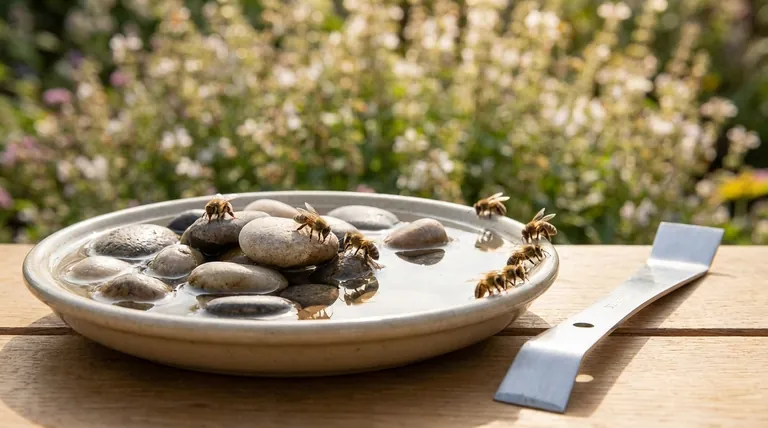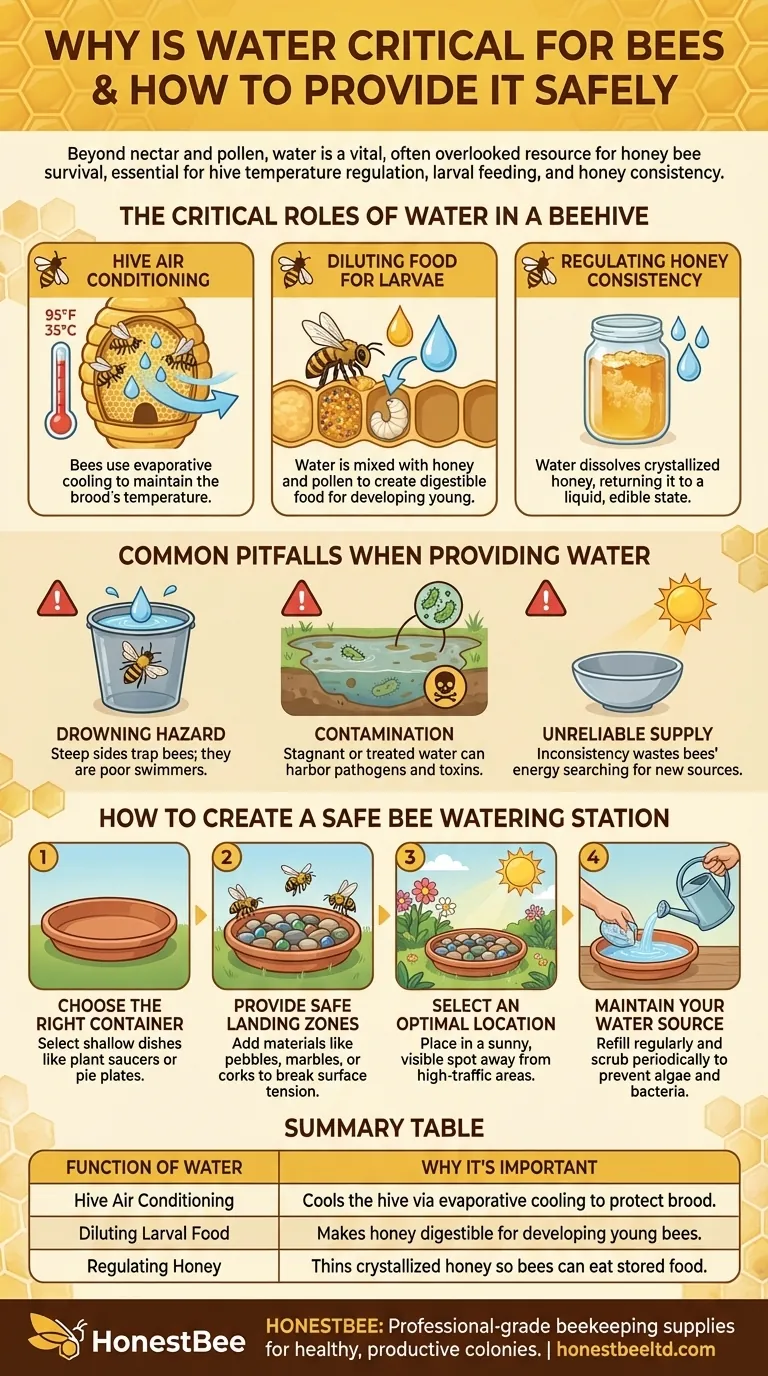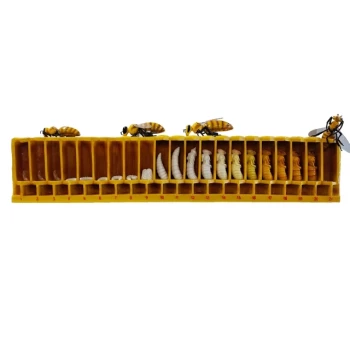Beyond nectar and pollen, water is a critical and often overlooked resource for honey bee survival. Bees require a consistent water source for several vital functions, from air conditioning the hive to preparing food for their young. You can easily provide it by setting up a shallow dish or bowl filled with water and arranged with safe landing spots like pebbles or stones.
The most important consideration when providing water for bees is safety. The goal is to create a reliable source where they can drink without the significant risk of drowning, which is a common danger in open water sources like pools or deep bird baths.

The Critical Roles of Water in a Beehive
While foraging for nectar and pollen is the most visible bee activity, you will also see them actively collecting water. This water is not just for drinking; it's a multi-purpose tool essential for the entire colony's health and stability.
Hive Air Conditioning
Bees must maintain the internal temperature of their hive within a very narrow range (around 95°F or 35°C) to ensure the proper development of their young, known as the brood.
On hot days, forager bees collect water and bring it back to the hive. House bees then spread tiny droplets of this water and fan it with their wings. This process of evaporative cooling works just like human sweat, lowering the internal temperature and protecting the delicate brood and wax comb from overheating.
Diluting Food for Larvae
Honey is the primary food source for adult bees, but it is far too concentrated for developing larvae.
Nurse bees consume honey and pollen, but they must mix it with water to produce a digestible, protein-rich slurry often called "bee bread" or a special secretion known as royal jelly. This watered-down food is essential for raising the next generation of bees.
Regulating Honey Consistency
Over time, stored honey can crystallize and become solid. To make this energy-rich food source edible again, bees use collected water to dissolve the sugar crystals, returning the honey to a liquid state.
Common Pitfalls When Providing Water
Creating a water source is simple, but a few common mistakes can do more harm than good. Being aware of these ensures your efforts are truly beneficial.
The Danger of Drowning
Bees are not strong swimmers. An open container with steep sides, like a bucket or a deep bowl, is a significant drowning hazard. A bee that falls in will likely be unable to climb out.
This is why shallow containers with landing pads are non-negotiable.
Water Source Contamination
A stagnant water source can quickly become a breeding ground for harmful bacteria and pathogens that can sicken an entire colony.
Furthermore, water that collects in areas treated with pesticides or herbicides can be toxic. Always use a dedicated container and fill it with fresh, clean water.
Unreliable Supply
Bees are creatures of habit. Once they locate a reliable water source, they will communicate its location to the rest of the hive. If that source suddenly dries up, they waste precious energy searching for a new one.
Consistency is key to making your water station truly helpful.
How to Create a Safe Bee Watering Station
Building an effective bee watering station is simple and requires only a few common materials.
Choose the Right Container
Select a shallow dish, like a plant saucer, a pie plate, or a bird bath. The shallower the container, the lower the risk of drowning.
Provide Safe Landing Zones
Fill the bottom of your container with materials that break the water's surface tension and give bees a place to land.
Excellent options include marbles, pebbles, small stones, twigs, or even wine corks. These items create many small, accessible pools of water that bees can safely drink from.
Select an Optimal Location
Place your water source in a visible, sunny spot. Bees are more likely to find it, and the sun will help them warm up if they get damp.
Position it away from high-traffic areas where they might be disturbed. Once established, try not to move it.
Maintain Your Water Source
Refill the container regularly, especially during hot, dry weather. Every few days, you should dump the old water and scrub the container to prevent algae and bacteria buildup before refilling with fresh water.
Making the Right Choice for Your Goal
Your approach can be tailored to your specific situation and commitment level.
- If your primary focus is supporting local pollinators in your garden: A single, shallow dish filled with pebbles and refreshed every few days is a perfect and effective solution.
- If your primary focus is managing your own apiary: Establish a larger, consistent water source within 50 feet of your hives to ensure your bees have a safe option and are less likely to visit a neighbor's swimming pool or other undesirable locations.
By thoughtfully providing this simple resource, you play an essential role in the health and productivity of these vital insects.
Summary Table:
| Function of Water | Why It's Important |
|---|---|
| Hive Air Conditioning | Cools the hive via evaporative cooling to protect brood. |
| Diluting Larval Food | Makes honey digestible for developing young bees. |
| Regulating Honey | Thins crystallized honey so bees can eat stored food. |
Ready to support your apiary with professional-grade equipment? HONESTBEE supplies durable, wholesale-focused beekeeping supplies and equipment to commercial apiaries and distributors. From hive tools to full setups, we help you maintain healthy, productive colonies. Contact us today to discuss your needs and discover how our solutions can benefit your operation!
Visual Guide

Related Products
- HONESTBEE Advanced Ergonomic Stainless Steel Hive Tool for Beekeeping
- Wholesales Dadant Size Wooden Bee Hives for Beekeeping
- Classic Wooden Bee Brush with Double-Row Boar Bristles
- 10L Stainless Steel Electric Honey Press Machine
- Wooden Bee Brush with Triple Row Artificial Fiber for Beekeeping
People Also Ask
- What are the basic tools for beekeeping? Essential Starter Kit for Safe & Successful Hive Management
- How is a hive tool used for scraping and cleaning? Master Hive Maintenance for a Healthy Colony
- What is a hive tool and what are its uses? Master Your Hive Inspections with the Essential Beekeeper's Tool
- What are some common uses of a hive tool? Essential Multi-Purpose Tool for Every Beekeeper
- What tools are used for cleaning frames? A Beekeeper's Simple 4-Tool Guide



















